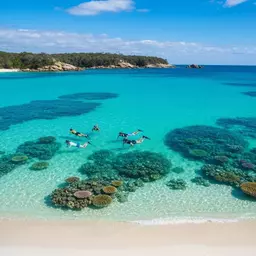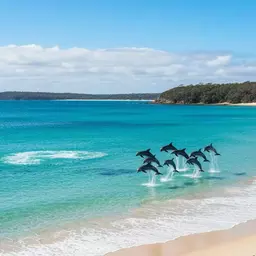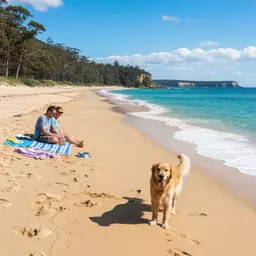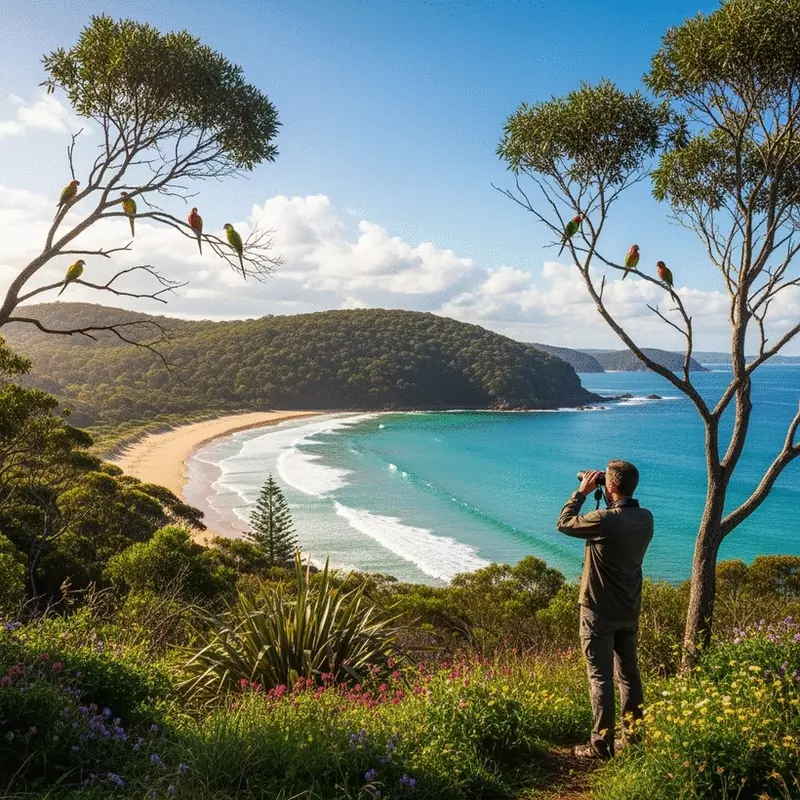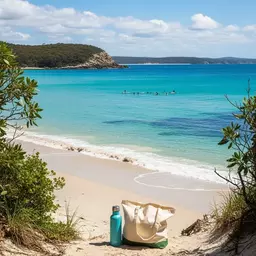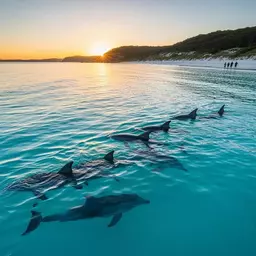Sustainable Fishing in Jervis Bay
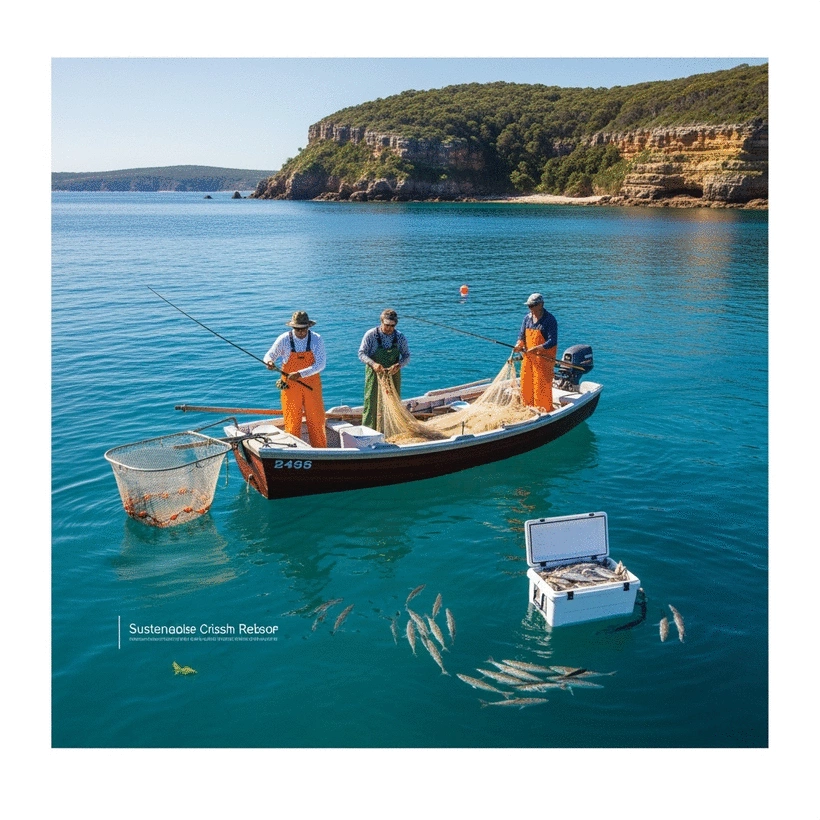
Have you ever pondered how your fishing habits affect the delicate balance of marine life? As we dive into the world of sustainable fishing in Jervis Bay, you'll discover how simple choices can lead to significant impacts on our oceans and the communities that rely on them.
What You Will Learn
- Sustainable fishing practices are crucial for maintaining fish populations and protecting marine ecosystems.
- Methods like hook and line fishing and trap fishing minimize bycatch and environmental disruption.
- Engaging in eco-friendly fishing tours enhances your fishing experience while promoting marine conservation.
- Following community guidelines and regulations is essential for preserving Jervis Bay’s fishing opportunities for future generations.
- Innovations in fishing gear and techniques support sustainable practices and reduce negative impacts on marine life.
Overview of Sustainable Fishing Practices and Benefits
This section highlights the key sustainable fishing practices and their associated environmental and socio-economic benefits. For more information on protecting Jervis Bay's natural beauty, read about sustainable travel tips for Jervis Bay.
Sustainable Fishing Practices
- Hook and line fishing
- Trap fishing
- Using nets responsibly
Environmental Benefits
- Maintaining healthy fish populations
- Protecting marine habitats
- Reducing pollution and habitat damage
Socio-economic Benefits
- Boosting local fisheries and creating jobs
- Empowering communities through responsible fishing
- Providing ethically sourced seafood
Monitoring and Assessing Sustainability
- Utilizing monitoring tools for fish populations
- Supporting regulatory frameworks
- Educating on sustainable practices
Understanding Sustainable Fishing Activities in Jervis Bay
When we think about fishing, often the idea revolves around sport or food. However, at Discover Jervis Bay, I believe it's crucial to look deeper into sustainable fishing. This practice not only helps in preserving our fish populations but also ensures the health of our stunning marine ecosystems. Have you ever considered how your fishing choices might impact the ocean?
In Jervis Bay, the concept of sustainable fishing is more than just a trend; it is a way to protect our beautiful coastal environment while enjoying its benefits. Understanding sustainable fishing means recognizing the importance of using methods that keep fish populations healthy and minimize environmental harm. This practice is essential for ensuring that future generations can also enjoy the rich marine biodiversity that Jervis Bay has to offer.
Defining Sustainable Fishing and Its Importance
Sustainable fishing entails fishing practices that do not deplete fish stocks or harm the environment. Here’s a quick look at what sustainable fishing involves:
- Using methods that prevent overfishing.
- Protecting habitats necessary for fish reproduction.
- Reducing bycatch, which refers to unintended species caught during fishing.
Why is this important? Because sustainable fishing practices help maintain the delicate balance of marine ecosystems. They ensure that fish populations can thrive while providing livelihoods for local communities. By embracing these practices, we can enjoy the beauty of Jervis Bay while contributing to its preservation.
Overview of Sustainable Fishing Practices
There are several sustainable fishing methods that are being adopted around Jervis Bay. These practices include:
- Hook and line fishing - This method allows for selective fishing, reducing the chance of catching non-target species.
- Trap fishing - Using traps can minimize bycatch and is less disruptive to marine habitats.
- Using nets responsibly - Ensuring nets are designed to reduce bycatch and have appropriate mesh sizes can protect juvenile fish.
By supporting these practices, we can help ensure that our fishing activities are not harming our precious oceans. Remember, every small effort counts!
Environmental and Socio-economic Benefits
Adopting sustainable fishing practices offers both environmental and socio-economic benefits. First, let's explore the environmental aspects:
- Maintaining healthy fish populations supports a balanced ecosystem.
- Protecting marine habitats helps sustain biodiversity.
- Reducing pollution and habitat damage leads to cleaner waterways.
On the socio-economic side:
- Sustainable practices can boost local fisheries, creating jobs and supporting local economies.
- They empower communities by promoting responsible fishing.
- Consumers can enjoy high-quality, fresh seafood that is ethically sourced.
As you can see, sustainable fishing is a win-win—it benefits both our environment and local communities. Let’s remember that when we choose how to fish, we also choose the future of Jervis Bay’s marine life!
Jervis Bay: A Unique Marine Ecosystem
Jervis Bay is not just about stunning beaches and breathtaking landscapes; it's home to a rich marine ecosystem. Did you know that the area is protected through the Jervis Bay Marine Park? This park is vital in safeguarding the diverse marine life that calls Jervis Bay home.
Exploring this unique ecosystem, you might encounter various species of fish, dolphins, and even seals! The preservation of these habitats is essential for maintaining the delicate balance of our marine environments. By understanding the importance of this area, we can all play a part in its protection, much like preserving the experience of kayaking in Jervis Bay.
Overview of Jervis Bay Marine Park
The Jervis Bay Marine Park was established to protect its rich biodiversity and beautiful ecosystems. Here’s what you should know:
- It encompasses over 102 square kilometers of pristine waters.
- The park includes a mix of marine environments, such as seagrass beds, rocky reefs, and sandy beaches.
- It is a haven for various wildlife, including migratory birds and endangered species.
This protection not only helps wildlife thrive but also allows visitors to experience the natural beauty of Jervis Bay responsibly. As we engage with this stunning area, we must keep in mind our role in its conservation.
Biodiversity and Conservation Zones
Within Jervis Bay Marine Park, there are specific zones dedicated to conservation. These zones aim to protect vital habitats and ensure the sustainability of marine life. Here’s a breakdown:
- Sanctuary Zones – Areas where fishing and collecting are prohibited to allow ecosystems to thrive.
- General Use Zones – Areas where sustainable fishing is allowed under specific regulations.
- Special Purpose Zones – Regions designated for activities such as research and education.
These zones are essential for maintaining the health of the marine environment. They allow us to enjoy activities like fishing while safeguarding our natural treasures.
Marine Biodiversity and Protected Areas
The marine biodiversity of Jervis Bay is something to be celebrated! The protected areas within the marine park are crucial for preserving various species, including:
- Common dolphins and seals that thrive in the bay’s waters.
- Unique fish species that contribute to the overall ecosystem.
- Seagrass meadows that provide habitat and nursery grounds.
By protecting these species and habitats, we not only help them survive but also ensure that future visitors can appreciate the incredible marine life Jervis Bay has to offer. So, as you plan your next adventure, remember the importance of sustainable practices and how they contribute to the beauty of this remarkable place!
Quick Summary
Here's a brief recap of the key points discussed so far:
- Sustainable fishing practices are essential for preserving fish populations and marine ecosystems.
- Jervis Bay Marine Park plays a critical role in safeguarding biodiversity and protecting marine life.
- Engaging in recreational fishing responsibly can contribute to the sustainability of the area.
Engaging in Recreational Sustainable Fishing Activities
When it comes to enjoying the stunning waters of Jervis Bay, participating in sustainable fishing is an experience that can be both fulfilling and environmentally conscious. I know from personal experience that being out on the water brings a sense of peace that’s hard to match! Engaging in recreational fishing allows you to connect with nature while ensuring we protect this beautiful ecosystem for future generations.
One of the best ways to enjoy fishing here is by opting for eco-friendly fishing tours and charters. These tours are designed to minimize environmental impact while maximizing your enjoyment. Have you ever considered what it feels like to fish in a way that respects local wildlife? It's a great feeling to know that your fishing practices are contributing to the sustainability of this exquisite marine area.
Eco-friendly Fishing Tours and Charters in Jervis Bay
Participating in eco-friendly fishing tours can transform your day out on the water into a memorable adventure. These charters often include expert guides who are passionate about marine conservation. It's not just about catching fish; it’s about immersing yourself in the wonders of Jervis Bay!
- Low-impact fishing experiences that promote conservation.
- Wildlife exploration alongside fishing for an unforgettable outing.
- Opportunities to learn more about Jervis Bay's unique marine ecosystem.
Imagine casting your line while witnessing dolphins playfully surfacing beside your boat! Charters often combine fishing with wildlife observation, offering a unique way to appreciate the vibrant life that inhabits these waters. Each trip you take helps you create lasting memories while supporting sustainable tourism.
Low-Impact Fishing Experiences
Low-impact fishing experiences are perfect for those who want to enjoy the thrill of fishing without contributing to overfishing or harming the environment. Many local tours focus on catch-and-release practices, which not only help maintain fish populations but also ensure a more sustainable fishing culture.
- Using barbless hooks to minimize injury to fish.
- Implementing catch limits to protect certain species.
- Educating participants about the local marine ecosystem.
By choosing these practices, you’re playing an active role in preserving Jervis Bay’s fish populations. It’s a wonderful way to connect with nature while being responsible!
Best Practices for Recreational Fishers
Whether you’re a seasoned angler or just starting, adopting best practices for sustainable fishing is essential. These practices not only help protect the environment but also enhance your fishing experience.
- Research local fishing regulations before you head out.
- Practice catch and release whenever possible.
- Choose the right gear that minimizes environmental impact.
Understanding the rules and regulations is crucial too! Make sure to familiarize yourself with local guidelines to ensure you're fishing responsibly. This is not just about protecting the fish; it's also about respecting fellow anglers and the community, much like finding the best family beaches in Jervis Bay.
Community Guidelines and Regulations to Follow
Jervis Bay is home to some fantastic fishing spots, but it's important to follow community guidelines and regulations. These rules are in place to ensure that fishing remains sustainable for everyone. Have you ever wondered how these regulations contribute to a healthy marine environment? They play a significant role!
- Stay informed about seasonal fishing closures.
- Understand size and bag limits for different species.
- Participate in local conservation programs.
By following these guidelines, you’re not just an angler; you’re a steward of the environment! It’s a positive step towards ensuring that future generations can enjoy Jervis Bay’s fishing opportunities just as we do today.
Monitoring and Assessing Sustainability Efforts
As we fish, it’s vital to monitor and assess sustainability efforts in our beloved Jervis Bay. This means keeping track of our fishing practices and their impact on the environment. After all, how else can we ensure that our actions today don’t harm the beautiful ecosystem we cherish?
- Utilize monitoring tools to track fish populations.
- Understand success metrics for sustainable fishing practices.
- Support regulatory frameworks that promote eco-friendly fishing.
By utilizing effective monitoring tools and supporting local regulations, we can ensure that our fishing practices contribute positively to the ecosystem. How rewarding it is to know that we can enjoy our fishing adventures responsibly!
Fisheries Research and Fishing Gear Innovations
Innovations in fishing gear and techniques are making sustainable fishing more accessible than ever. Fisheries research plays a crucial role in understanding the health of our fish populations. Have you ever thought about how the tools we use can impact marine life?
- Investing in biodegradable fishing gear.
- Adopting new techniques that reduce bycatch.
- Participating in community events focused on sustainable practices.
These innovations not only enhance our fishing experience but also ensure we’re doing our part in preserving the environment. Join me in exploring these exciting developments and promote sustainability while enjoying our time on the water! For more on Jervis Bay's diverse marine life, consider learning about wildlife encounters in Jervis Bay.
Recap of Key Points
Here is a quick recap of the important points discussed in the article:
- Sustainable Fishing Practices: Emphasizes methods that prevent overfishing, protect habitats, and reduce bycatch.
- Environmental and Socio-economic Benefits: Highlights the balance of marine ecosystems and the support for local communities through sustainable practices.
- Jervis Bay Marine Park: A protected area vital for preserving marine biodiversity and providing a unique experience for visitors.
- Recreational Fishing Guidelines: Encourages catch and release, understanding local regulations, and using responsible fishing gear.
- Monitoring Sustainability Efforts: Stresses the importance of tracking fish populations and supporting eco-friendly regulations.
- Innovations in Fishing Gear: Promotes the use of biodegradable gear and new techniques that minimize environmental impact.
Frequently Asked Questions About Sustainable Fishing in Jervis Bay
- What is sustainable fishing?
- Sustainable fishing involves practices that prevent overfishing, protect marine habitats, and reduce bycatch, ensuring fish populations remain healthy for future generations.
- Why is sustainable fishing important in Jervis Bay?
- It's crucial for preserving the delicate balance of Jervis Bay's unique marine ecosystem, maintaining healthy fish populations, and supporting local communities and tourism.
- What are some examples of sustainable fishing methods?
- Examples include hook and line fishing, trap fishing, and responsible net use (with appropriate mesh sizes) that minimize harm to non-target species and habitats.
- How does Jervis Bay Marine Park contribute to sustainable fishing?
- The Marine Park protects diverse marine life and habitats through designated zones (Sanctuary, General Use, Special Purpose), regulating fishing activities to ensure sustainability.
- What can recreational fishers do to practice sustainable fishing?
- Recreational fishers can follow local regulations, practice catch and release, use barbless hooks, choose eco-friendly fishing tours, and stay informed about seasonal closures and bag limits.
- Are there eco-friendly fishing tours available in Jervis Bay?
- Yes, many eco-friendly fishing tours and charters in Jervis Bay offer low-impact experiences, often combining fishing with wildlife observation and promoting conservation.
- How do innovations in fishing gear support sustainability?
- Innovations like biodegradable fishing gear and new techniques that reduce bycatch help minimize environmental impact and enhance the sustainability of fishing practices.
